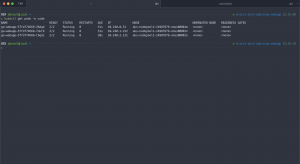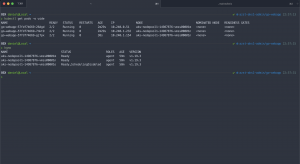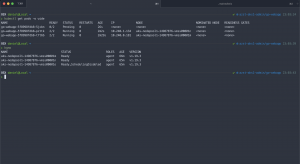This is the second blog post of a series of posts covering the topic about increasing the application availability on Azure Kubernetes Services / Kubernetes.
Today we cover the pod anti-affinity setting.
What is the pod anti-affinity?
In the first post of the series, I talked about the PodDisruptionBudget. The PDB guarantees that a certain amount of your application pods is available.
Defining a pod anti-affinity is the next step increasing your application’s availability. A pod anti-affinity guarantees the distribution of the pods across different nodes in your Kubernetes cluster.
You can define a soft or a hard pod anti-affinity for your application.
The soft anti-affinity is best-effort and might lead to the state that a node runs two replicas of your application instead of distributing it across different nodes.
Using the hard anti-affinity guarantees the distribution across different nodes in your cluster. The only downside using the hard anti-affinity in certain circumstances is a reduction in the overall replica count of your deployment when a node or several nodes have an outage.
Combined with a PDB this can also lead to a deadlock.
So, I recommend using the soft anti-affinity.
Using the pod anti-affinity setting
Let us have a look at the following Kubernetes template which makes use of the pod anti-affinity.
...
template:
metadata:
labels:
app: go-webapp
version: v1
spec:
affinity:
podAntiAffinity:
preferredDuringSchedulingIgnoredDuringExecution:
- weight: 100
podAffinityTerm:
labelSelector:
matchExpressions:
- key: app
operator: In
values:
- go-webapp
topologyKey: kubernetes.io/hostname
containers:
...
In the template itself I am using a soft anti-affinity which is defined using the term preferredDuringSchedulingIgnoredDuringExecution where a hard anti-affinity is defined by requiredDuringSchedulingIgnoredDuringExecution.
The soft anti-affinity has a special configuration setting called weight which is added to the scheduler calculation controlling the likelihood distributing the pods across different nodes. 1 is the lowest value and 100 the highest. When you want a higher chance of distributing the pods across different nodes with the soft anti-affinity use the value 100 here.
The labelSelector and topologyKey then defines how the scheduling works. The definition above is read like this: A pod should not be scheduled on the node if a pod with the label app=go-webapp is already running on it.
When we deploy our template on the AKS cluster all our replicas run on different nodes.
> kubectl get pods -o wide NAME READY STATUS RESTARTS AGE IP NODE NOMINATED NODE READINESS GATES go-webapp-75c66f85cf-984sk 2/2 Running 0 41s 10.240.0.28 aks-nodepool1-14987876-vmss00001m <none> <none> go-webapp-75c66f85cf-plnk5 2/2 Running 0 26s 10.240.2.10 aks-nodepool1-14987876-vmss00001o <none> <none> go-webapp-75c66f85cf-twck2 2/2 Running 0 41s 10.240.1.145 aks-nodepool1-14987876-vmss00001n <none> <none>
Frankly, Kubernetes always tries to distribute your application pods across different nodes. But the pod anti-affinity allows you to better control it.
Soft vs. hard anti-affinity
As mentioned previously soft is best-effort and hard guarantees the distribution. For instance, let us deploy the Kubernetes template on a Docker for Mac single node Kubernetes cluster. First time with the soft anti-affinity setting and the second time with the hard anti-affinity setting.
...
template:
metadata:
labels:
app: go-webapp
version: v1
spec:
affinity:
podAntiAffinity:
requiredDuringSchedulingIgnoredDuringExecution:
- labelSelector:
matchExpressions:
- key: app
operator: In
values:
- go-webapp
topologyKey: kubernetes.io/hostname
containers:
...
Using the soft anti-affinity setting brings up all three replicas compared to the one replica using the hard anti-affinity setting.
### Soft anti-affinity ### > kubectl get pods -o wide NAME READY STATUS RESTARTS AGE IP NODE NOMINATED NODE READINESS GATES go-webapp-666859f746-hnnrv 2/2 Running 0 59s 10.1.0.65 docker-desktop <none> <none> go-webapp-666859f746-ltgvr 2/2 Running 0 82s 10.1.0.64 docker-desktop <none> <none> go-webapp-666859f746-tjqqp 2/2 Running 0 38s 10.1.0.66 docker-desktop <none> <none> ### Hard anti-affinity ### > kubectl get pods -o wide NAME READY STATUS RESTARTS AGE IP NODE NOMINATED NODE READINESS GATES go-webapp-5748776476-cxq76 0/2 Pending 0 48s <none> <none> <none> <none> go-webapp-5748776476-sdnkj 2/2 Running 0 74s 10.1.0.67 docker-desktop <none> <none> go-webapp-5748776476-twwbt 0/2 Pending 0 48s <none> <none> <none> <none>
Also have a look at the following screenshots where I did the same on the AKS cluster and drained one of the nodes.
As you see using the hard anti-affinity leads to a state where the overall replica count is reduced until a new node is available to host the pod.
What protection provides the pod anti-affinity?
The pod anti-affinity provides protection against node failures and thus ensures a higher availability of your application.
Summary
Using the pod anti-affinity protects your application against node failures distributing the pods across different nodes on a best-effort or guarantee basis.
As mentioned earlier Kubernetes always tries to distribute your application pods across different nodes even without a specified pod anti-affinity. But the pod anti-affinity allows you to better control it.
You can even go further and use another topologyKey like topology.kubernetes.io/zone protecting your application against zonal failures.
A better solution for this are pod topology spread constraints which reached the stable feature state with Kubernetes 1.19.
I will cover pod topology spread constraints in the next blog post of this series. Stay tuned.


